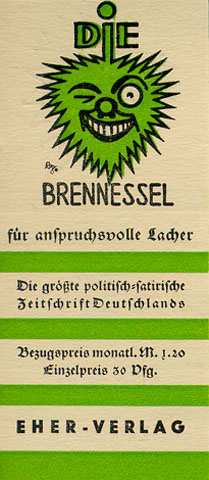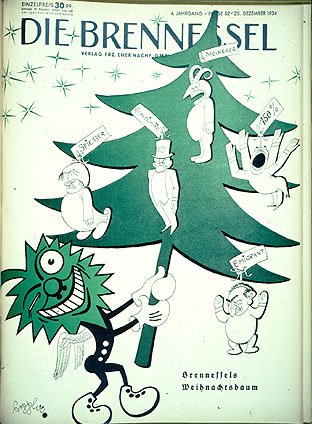
Background: Brennessel was the Nazi humor magazine, published from 1931 to 1938. It wasn’t very funny. The circulation declined steadily during the Nazi era until it finally ceased publication. As in other areas (e. g., film), the Nazis found that it was hard to persuade people to buy dull propaganda. These cartoons are from 1934, with one exception. The dates are given in parentheses. For further details, see my essay: “The Dolt Laughs: Satirical Publications under Hitler and Honecker,” Journalism Quarterly, 69 (1992), pp. 1029-1038.
Source: My collection
Cartoons from Die Brennessel
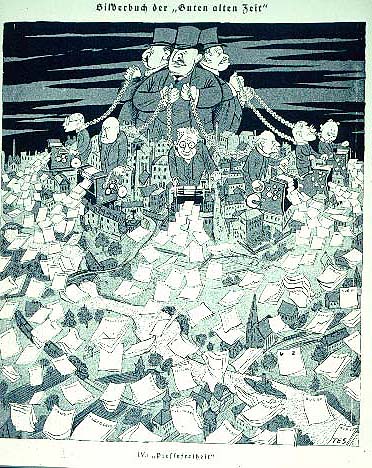
Caption: “A Scene from the ‘Good Old Days.’” The theme is freedom of the press. This supposedly depicts the situation before 1933, when the Nazis claimed the Jews controlled the German press. (2 January 1934)

Caption: “Then and Now.” The cartoon shows a Jew stealing a farm before the Nazi takeover, but afterwards he is stopped by the law. (16 January 1934)
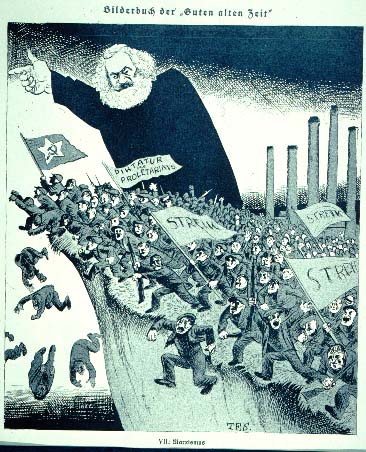
Caption: “A Scene from the ‘Good Old Days.’” The claim is that Marxism was leading German workers to their destruction before Hitler’s takeover. (23 January 1934)

Caption: “If you give people enough time, they get the idea.” A Jew, a communist and a socialist are talking, “It’s been a year and they still have not let us back in. It is beginning to look like they don’t want us...” (30 January 1934)
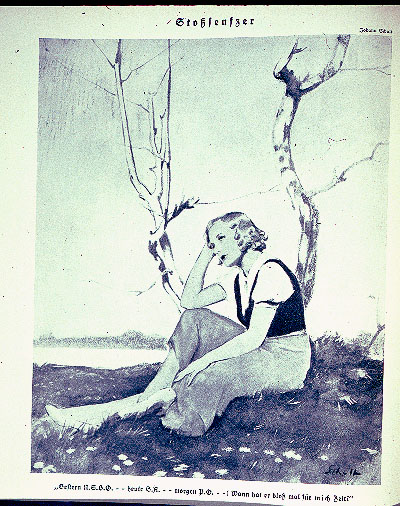
Caption: “Yesterday the NSBO, today the S.A., tomorrow the P. O. When will he have time for me?” The point is that a loyal Nazi went to lots of meetings. (30 January 1934)

Caption: This was before Hitler took over Austria, and was unhappy with the Austrian government. Two Austrian police are beating a woman. The third policeman tells the Jewish reporter than he can’t write about the incident. The reporter says that it is OK, since he is using it as a story about Nazi atrocities in Germany. (20 February 1934)
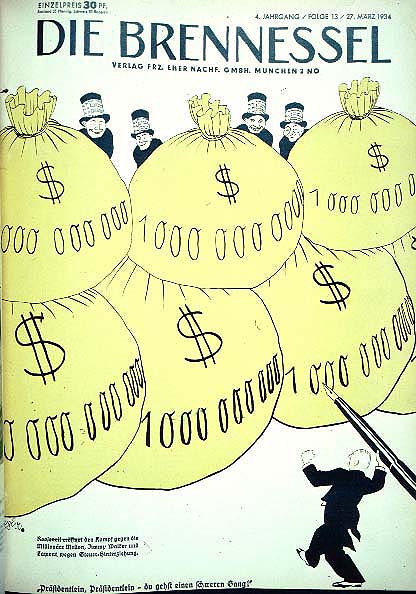
Caption: “Roosevelt declares war on the millionaire tax-evaders Mellon, Jimmy Walker, and Lamont. Mr. President, Mr. President, you have a hard job!” Jews are hiding behind a wall of money bags. (27 March 1934)

Caption: “Diogenes 1934.” Diogenes in the form of the British prime minister is looking for a disarmament plan. (17 April 1934)
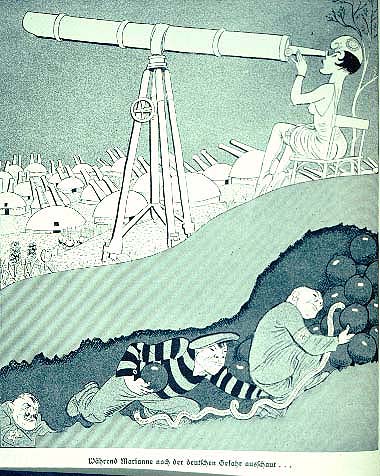
Caption: “While France Looks to Danger from Germany...” Marianne, the symbol for France, has all her guns pointing toward Germany while communists are tunneling in from underneath. (17 April 1934)
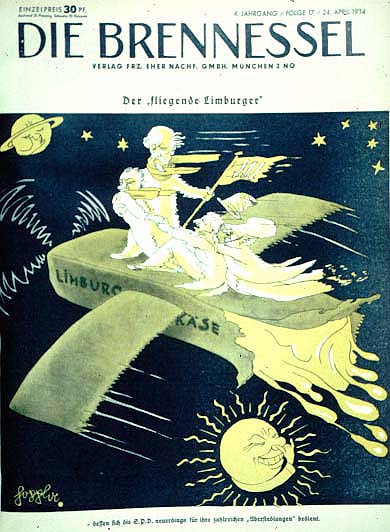
Caption: “The Flying Limberger that has carried so many SPD members abroad.” The point is that many socialists were fleeing Germany. The cartoon suggests that Germany is better off without them. (24 April 1934)
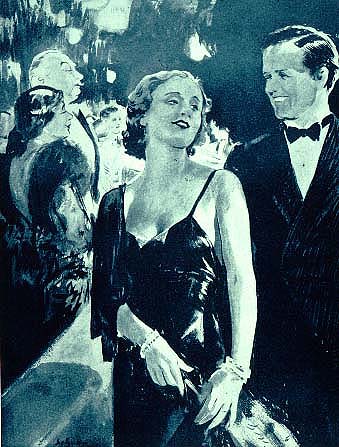
Caption: “Conversation at Midnight.” The woman says “My dog ran away.” He replies: “Did you put an ad in the paper?” She says: “Of course not. My dog can’t read.” (3 July 1934)
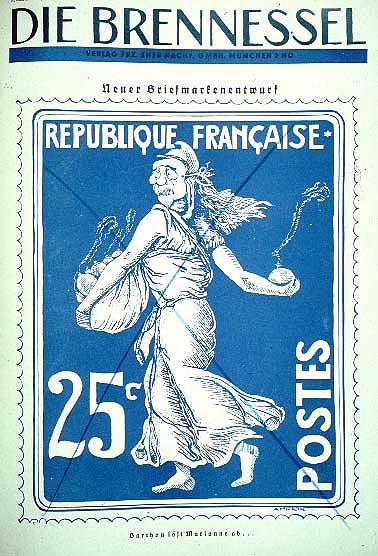
Caption: “A Proposal for a New Postage Stamp”: Bombs instead of produce. One Barthou is mentioned at the bottom, apparently a French politician. This cartoon did not make it — it was censored before the issue was circulated. (24 July 1934)
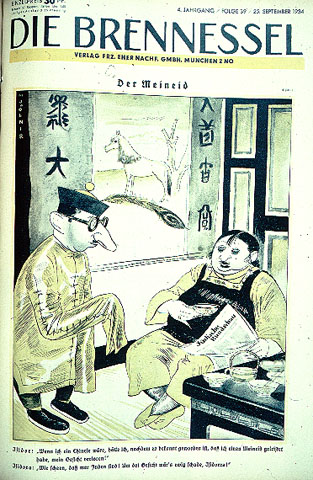
Caption: “Perjury.” Isidor (Joseph Goebbels’ pejorative nickname for Bernhard Weiss, a leader of the Berlin police before 1933) says: “Were I Chinese, I would have lost face once it was learned that I had committed perjury.” His wife responds: “How fortune that we are Jews. Your face was never that attractive to begin with, Isidor!” (25 September 1934). Compare this to a 1928 Goebbels essay on the same theme.
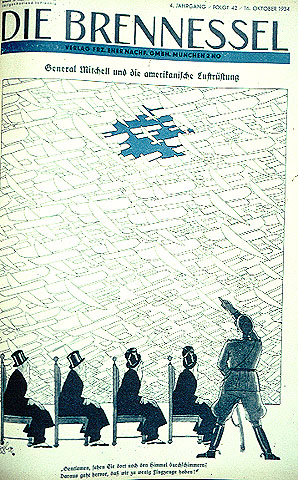
Caption: “General Mitchell and the American Air Force.” Mitchell is saying: “Gentlemen, see the spot of sky up there? That’s because we do not have enough airplanes.” (16 October 1934)
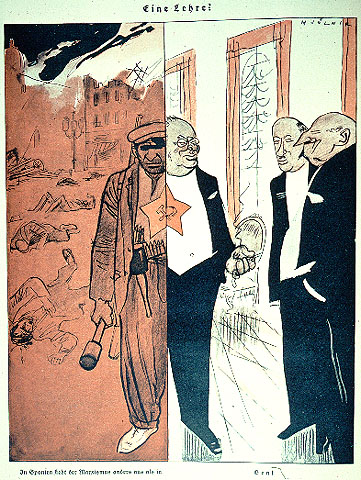
Caption: “A Lesson?” The left shows the face of Soviet Marxism in Spain (in events that led up to the Spanish Civil War), to the right the cultivated Marxist diplomat. But, the cartoon suggests, they are one and the same. (23 October 1934)
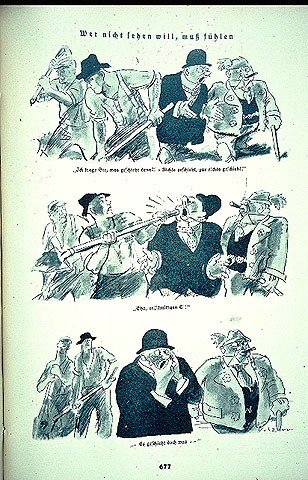
Caption: “Those who can’t see will feel it...” In the top frame, two men are complaining that nothing is happening in Germany. The two workers are annoyed, so one “accidentally” directs his shovel handle to the jaw of a complainer. In the bottom, one worker says to another: “Something happened after all...” This was part of a general Nazi campaign against complainers, and also suggests why Brennessel failed. It had precious little room to criticize. (23 October 1934)

Caption: “Sacrifice”. The woman in the car is telling her driver, delivering a 1 pfennig coin to the Nazi charity: “Give them that, Jean. That will show that the appeal to the rich has not gone unheard.” (30 October 1934)

Caption: “Kurfürstendamm 1960.” The Kudamm is a major Berlin shopping street. Two Jews are talking. “Let me tell you, two months and the Nazis will be gone.” This is a commentary on claims in 1934 that Hitler’s days were numbered. (6 November 1934)

Caption: “The Emigré Press.” Numerous German journalists left Germany after 1933. Some founded German-language newspapers abroad. Here, a Jew is injecting lies, and the innocent reader is paying money for them. (30 November 1934)
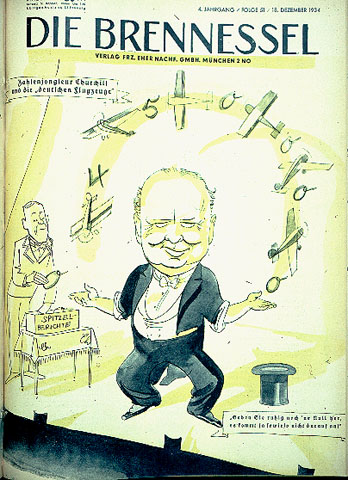
Caption: “Churchill juggles the figures.” Churchill is saying: “Add another zero to the German figures. It won’t make any difference.” The claim is that the British are exaggerating German armaments production. (18 December 1934)
